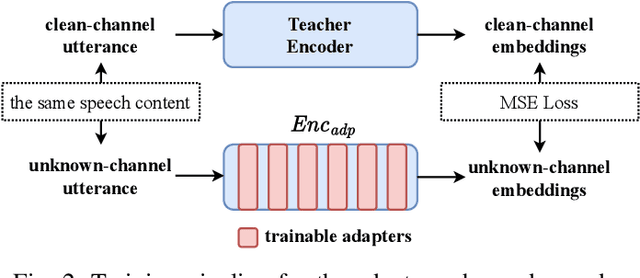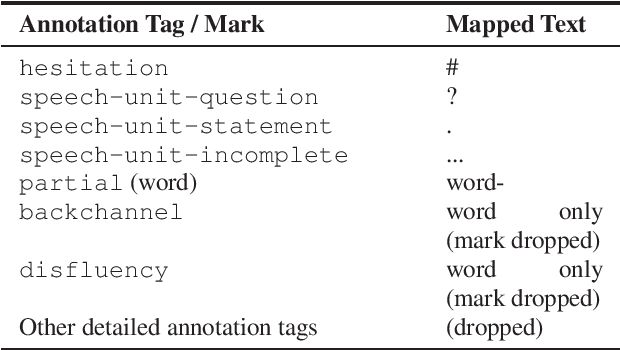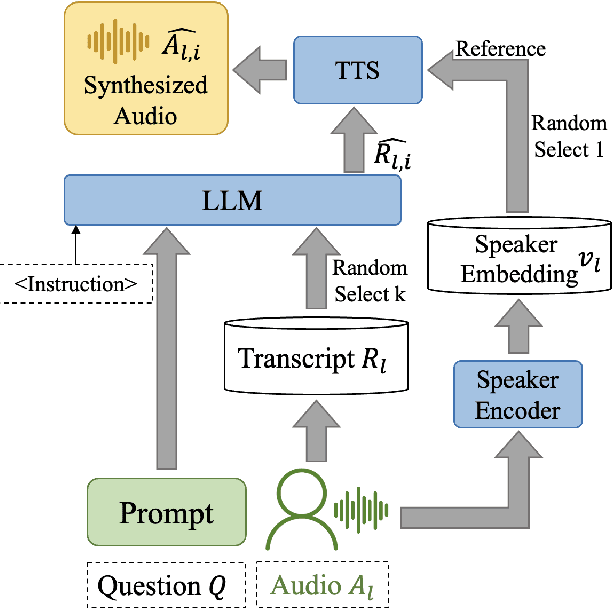Berlin Chen
CLiFT-ASR: A Cross-Lingual Fine-Tuning Framework for Low-Resource Taiwanese Hokkien Speech Recognition
Nov 10, 2025Abstract:Automatic speech recognition (ASR) for low-resource languages such as Taiwanese Hokkien is difficult due to the scarcity of annotated data. However, direct fine-tuning on Han-character transcriptions often fails to capture detailed phonetic and tonal cues, while training only on romanization lacks lexical and syntactic coverage. In addition, prior studies have rarely explored staged strategies that integrate both annotation types. To address this gap, we present CLiFT-ASR, a cross-lingual fine-tuning framework that builds on Mandarin HuBERT models and progressively adapts them to Taiwanese Hokkien. The framework employs a two-stage process in which it first learns acoustic and tonal representations from phonetic Tai-lo annotations and then captures vocabulary and syntax from Han-character transcriptions. This progressive adaptation enables effective alignment between speech sounds and orthographic structures. Experiments on the TAT-MOE corpus demonstrate that CLiFT-ASR achieves a 24.88\% relative reduction in character error rate (CER) compared with strong baselines. The results indicate that CLiFT-ASR provides an effective and parameter-efficient solution for Taiwanese Hokkien ASR and that it has potential to benefit other low-resource language scenarios.
MuFFIN: Multifaceted Pronunciation Feedback Model with Interactive Hierarchical Neural Modeling
Oct 06, 2025Abstract:Computer-assisted pronunciation training (CAPT) manages to facilitate second-language (L2) learners to practice pronunciation skills by offering timely and instructive feedback. To examine pronunciation proficiency from multiple facets, existing methods for CAPT broadly fall into two categories: mispronunciation detection and diagnosis (MDD) as well as automatic pronunciation assessment (APA). The former aims to pinpoint phonetic pronunciation errors and provide diagnostic feedback, while the latter seeks instead to quantify pronunciation proficiency pertaining to various aspects. Despite the natural complementarity between MDD and APA, researchers and practitioners, however, often treat them as independent tasks with disparate modeling paradigms. In light of this, we in this paper first introduce MuFFIN, a Multi-Faceted pronunciation Feedback model with an Interactive hierarchical Neural architecture, to jointly address the tasks of MDD and APA. To better capture the nuanced distinctions between phonemes in the feature space, a novel phoneme-contrastive ordinal regularization mechanism is then put forward to optimize the proposed model to generate more phoneme-discriminative features while factoring in the ordinality of the aspect scores. In addition, to address the intricate data imbalance problem in MDD, we design a simple yet effective training objective, which is specifically tailored to perturb the outputs of a phoneme classifier with the phoneme-specific variations, so as to better render the distribution of predicted phonemes meanwhile considering their mispronunciation characteristics. A series of experiments conducted on the Speechocean762 benchmark dataset demonstrates the efficacy of our method in relation to several cutting-edge baselines, showing state-of-the-art performance on both the APA and MDD tasks.
Session-Level Spoken Language Assessment with a Multimodal Foundation Model via Multi-Target Learning
Sep 19, 2025Abstract:Spoken Language Assessment (SLA) estimates a learner's oral proficiency from spontaneous speech. The growing population of L2 English speakers has intensified the demand for reliable SLA, a critical component of Computer Assisted Language Learning (CALL). Existing efforts often rely on cascaded pipelines, which are prone to error propagation, or end-to-end models that often operate on a short audio window, which might miss discourse-level evidence. This paper introduces a novel multimodal foundation model approach that performs session-level evaluation in a single pass. Our approach couples multi-target learning with a frozen, Whisper ASR model-based speech prior for acoustic-aware calibration, allowing for jointly learning holistic and trait-level objectives of SLA without resorting to handcrafted features. By coherently processing the entire response session of an L2 speaker, the model excels at predicting holistic oral proficiency. Experiments conducted on the Speak & Improve benchmark demonstrate that our proposed approach outperforms the previous state-of-the-art cascaded system and exhibits robust cross-part generalization, producing a compact deployable grader that is tailored for CALL applications.
Beyond Modality Limitations: A Unified MLLM Approach to Automated Speaking Assessment with Effective Curriculum Learning
Aug 18, 2025Abstract:Traditional Automated Speaking Assessment (ASA) systems exhibit inherent modality limitations: text-based approaches lack acoustic information while audio-based methods miss semantic context. Multimodal Large Language Models (MLLM) offer unprecedented opportunities for comprehensive ASA by simultaneously processing audio and text within unified frameworks. This paper presents a very first systematic study of MLLM for comprehensive ASA, demonstrating the superior performance of MLLM across the aspects of content and language use . However, assessment on the delivery aspect reveals unique challenges, which is deemed to require specialized training strategies. We thus propose Speech-First Multimodal Training (SFMT), leveraging a curriculum learning principle to establish more robust modeling foundations of speech before cross-modal synergetic fusion. A series of experiments on a benchmark dataset show MLLM-based systems can elevate the holistic assessment performance from a PCC value of 0.783 to 0.846. In particular, SFMT excels in the evaluation of the delivery aspect, achieving an absolute accuracy improvement of 4% over conventional training approaches, which also paves a new avenue for ASA.
QAMRO: Quality-aware Adaptive Margin Ranking Optimization for Human-aligned Assessment of Audio Generation Systems
Aug 12, 2025Abstract:Evaluating audio generation systems, including text-to-music (TTM), text-to-speech (TTS), and text-to-audio (TTA), remains challenging due to the subjective and multi-dimensional nature of human perception. Existing methods treat mean opinion score (MOS) prediction as a regression problem, but standard regression losses overlook the relativity of perceptual judgments. To address this limitation, we introduce QAMRO, a novel Quality-aware Adaptive Margin Ranking Optimization framework that seamlessly integrates regression objectives from different perspectives, aiming to highlight perceptual differences and prioritize accurate ratings. Our framework leverages pre-trained audio-text models such as CLAP and Audiobox-Aesthetics, and is trained exclusively on the official AudioMOS Challenge 2025 dataset. It demonstrates superior alignment with human evaluations across all dimensions, significantly outperforming robust baseline models.
Revealing the Role of Audio Channels in ASR Performance Degradation
Aug 12, 2025



Abstract:Pre-trained automatic speech recognition (ASR) models have demonstrated strong performance on a variety of tasks. However, their performance can degrade substantially when the input audio comes from different recording channels. While previous studies have demonstrated this phenomenon, it is often attributed to the mismatch between training and testing corpora. This study argues that variations in speech characteristics caused by different recording channels can fundamentally harm ASR performance. To address this limitation, we propose a normalization technique designed to mitigate the impact of channel variation by aligning internal feature representations in the ASR model with those derived from a clean reference channel. This approach significantly improves ASR performance on previously unseen channels and languages, highlighting its ability to generalize across channel and language differences.
JCAPT: A Joint Modeling Approach for CAPT
Jun 24, 2025Abstract:Effective pronunciation feedback is critical in second language (L2) learning, for which computer-assisted pronunciation training (CAPT) systems often encompass two key tasks: automatic pronunciation assessment (APA) and mispronunciation detection and diagnosis (MDD). Recent work has shown that joint modeling of these two tasks can yield mutual benefits. Our unified framework leverages Mamba, a selective state space model (SSM), while integrating phonological features and think token strategies to jointly enhance interpretability and fine-grained temporal reasoning in APA and MDD. To our knowledge, this is the first study to combine phonological attribution, SSM-based modeling, and prompting in CAPT. A series of experiments conducted on the speechocean762 benchmark demonstrate that our model consistently outperforms prior methods, particularly on the MDD task.
The NTNU System at the S&I Challenge 2025 SLA Open Track
Jun 05, 2025Abstract:A recent line of research on spoken language assessment (SLA) employs neural models such as BERT and wav2vec 2.0 (W2V) to evaluate speaking proficiency across linguistic and acoustic modalities. Although both models effectively capture features relevant to oral competence, each exhibits modality-specific limitations. BERT-based methods rely on ASR transcripts, which often fail to capture prosodic and phonetic cues for SLA. In contrast, W2V-based methods excel at modeling acoustic features but lack semantic interpretability. To overcome these limitations, we propose a system that integrates W2V with Phi-4 multimodal large language model (MLLM) through a score fusion strategy. The proposed system achieves a root mean square error (RMSE) of 0.375 on the official test set of the Speak & Improve Challenge 2025, securing second place in the competition. For comparison, the RMSEs of the top-ranked, third-ranked, and official baseline systems are 0.364, 0.384, and 0.444, respectively.
Acoustically Precise Hesitation Tagging Is Essential for End-to-End Verbatim Transcription Systems
Jun 04, 2025



Abstract:Verbatim transcription for automatic speaking assessment demands accurate capture of disfluencies, crucial for downstream tasks like error analysis and feedback. However, many ASR systems discard or generalize hesitations, losing important acoustic details. We fine-tune Whisper models on the Speak & Improve 2025 corpus using low-rank adaptation (LoRA), without recourse to external audio training data. We compare three annotation schemes: removing hesitations (Pure), generic tags (Rich), and acoustically precise fillers inferred by Gemini 2.0 Flash from existing audio-transcript pairs (Extra). Our challenge system achieved 6.47% WER (Pure) and 5.81% WER (Extra). Post-challenge experiments reveal that fine-tuning Whisper Large V3 Turbo with the "Extra" scheme yielded a 5.5% WER, an 11.3% relative improvement over the "Pure" scheme (6.2% WER). This demonstrates that explicit, realistic filled-pause labeling significantly enhances ASR accuracy for verbatim L2 speech transcription.
A Novel Data Augmentation Approach for Automatic Speaking Assessment on Opinion Expressions
Jun 04, 2025



Abstract:Automated speaking assessment (ASA) on opinion expressions is often hampered by the scarcity of labeled recordings, which restricts prompt diversity and undermines scoring reliability. To address this challenge, we propose a novel training paradigm that leverages a large language models (LLM) to generate diverse responses of a given proficiency level, converts responses into synthesized speech via speaker-aware text-to-speech synthesis, and employs a dynamic importance loss to adaptively reweight training instances based on feature distribution differences between synthesized and real speech. Subsequently, a multimodal large language model integrates aligned textual features with speech signals to predict proficiency scores directly. Experiments conducted on the LTTC dataset show that our approach outperforms methods relying on real data or conventional augmentation, effectively mitigating low-resource constraints and enabling ASA on opinion expressions with cross-modal information.
 Add to Chrome
Add to Chrome Add to Firefox
Add to Firefox Add to Edge
Add to Edge